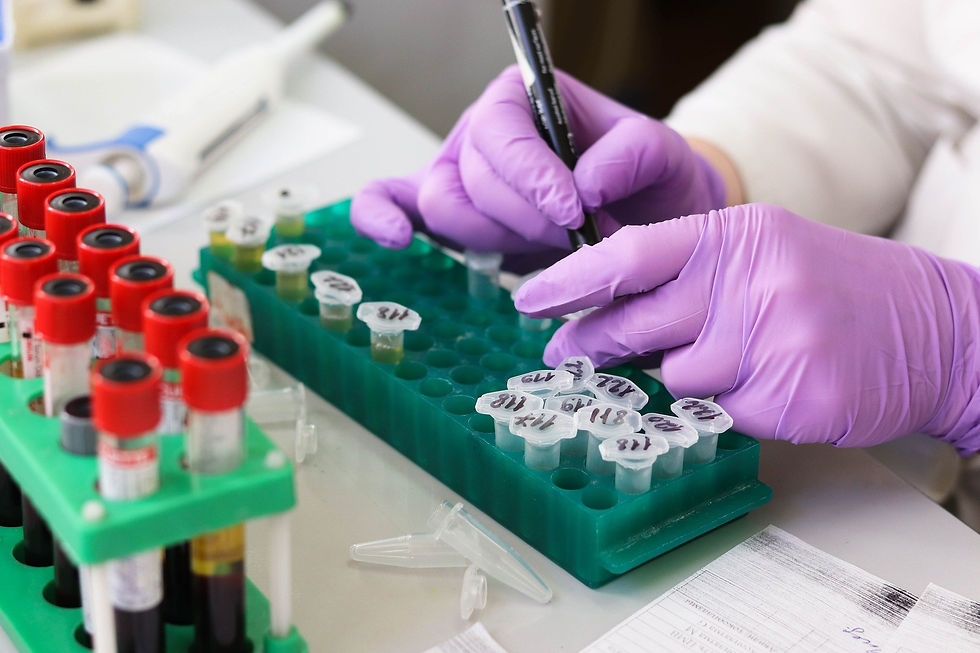GPR75 – Is It The Future Of Weight Loss?
- Eureka WSRC
- Sep 21, 2021
- 4 min read
Updated: Sep 25, 2021
Chances are that you may have come across the word “genes” being used in a conversation about
fitness and athleticism. Although this aspect is quite ambiguous to common people, the scientific
world has made massive advancements in deciphering how genomic sequences can be used as
well as developed upon to be able to deliver desired results. Traditional methods of losing weight
include Exercise, dieting and a couple of other nutritional and lifestyle changes that a person
would have to make. Not only do these methods require immense levels of commitment,
dedication, focus and hours of hard work, but fully implementing them comes with a detrimental
price to pay (quite literally). A recent study conducted by Marketdata Enterprises, a market and
service research business that specializes in tracking niche sectors, has found that Americans
manage to spend almost $60 billion annually in weight-loss and fitness programs.
However, recent scientific breakthroughs in the fields of biotechnology, and regenerative
medicine have allowed scientists to come up with probable theories, conclusions and maybe even
an easier solution to targeting weight gain for example. With regard to the latest technological
advancements, methods such as Whole Exome Sequencing (WES) wherein sequencing all the
genomic exons helps identify mutations or variations in the protein-specific region of a gene
have assisted in identifying probable gene related causes of not only diseases but more
importantly, conditions such as morbid obesity and debilitating orthopedic deformities.
The type of gene in focus is known as the G Protein-Coupled Receptor (GPCR). In the most
basic sense, they are cell surface membrane receptors which act as message receivers. These
definitive messages manage to inform cells if there are any vital nutrients or substances absent or
present in the body. When it comes to signaling, most modern organisms use GPCR’s for very
specific factors such as monitoring levels of glucose in the bloodstream. Linking this to us
humans, it is estimated that our bodies may contain more than 1,000 different GPCR’s, each
responsible for a single biological signal.

With regard to the aforementioned concept of WES, many conditions, and diseases stem from
mutations in a GPCR. By taking obesity as an example, research done by New York based
pharmaceutical firm Regeneron Inc manages to express a link between mutated genes and weight
gain. A team of researchers from the Regeneron Genetic Centre (RGC) conducted a study which
consisted of sequencing the particular exomes of 640,000 individuals which were part of a
culturally diverse cohort, showed that around 16 or more genes have a connection to the Body
Mass Index (BMI). Within those selected 16, five were signal related GPCRs and one mutated
variant within those 5 managed to show a 54% lesser chance of developing obesity in the long
run.
More so along with scientists from RGC, a panel of experts from the New York Medical College
(NYMC) lead by Dr Michel Schwartzman and Dr Victor Garcia, both professors of
Pharmacology; were able to come up with an initial finding which claimed that people with a
mutated version of GPR75 weighed almost 12 pounds lesser than people with a functioning
version of the gene. To further support their elementary theory, both teams used Regeneron’s

VelociMouse technique wherein altered embryonic stem cells containing the genetically
engineered gene is injected into the surrogate mother (in this case mice), with this, all the
immediate offspring of the surrogate mother contain the modified gene. If this was done using
the regular method in science, multiple generations would have to be individually examined,
only resulting in a few mice who had managed to receive a direct copy. The old method proved
to be very cumbersome as it took too much effort and far too much time, thereby lengthening the
process of a study.
As this study involved the GPR75, the team inactivated the already in-built gene in the mice.
Once the “knockout” (the sample which was being tested) mice had received the gene, they
gathered another group of mice whose genetic systems had not been tampered with these were
classified as the “control” group, both groups of mice were then fed a high-fat diet which was
continuously monitored to be uniform in all terms. At the end of the experiment, it was observed
that the knockout mice gained almost 12 pounds/5.4 kilograms less compared to the control
group.

As mentioned earlier, worsened health conditions are always a by-product of an unhealthy life.
Scientists are currently working day and night to identify whether or not complementary diseases
due to weight gain, such as diabetes can be combated using a similar method involving
engineering.
We all still have a long journey to go before genomic changes regarding weight gain can be
widespread amongst the population, but that day is slowly inching towards us. Eventually, we
may even be able to manipulate and alter genes before a child is born.
Zayd Anis
________________________________________________________________________________
Citations
Akbari P;Gilani A;Sosina O;Kosmicki JA;Khrimian L;Fang YY;Persaud T;Garcia V;Sun D;Li
A;Mbatchou J;Locke AE;Benner C;Verweij N;Lin N;Hossain S;Agostinucci K;Pascale
JV;Dirice E;Dunn M; ; ;Kraus WE;Shah SH;Chen YI;Rotter JI;Rader DJ;Melander
O;Still CD;Mirshahi T;Carey DJ;Berumen-Campos J;Kuri-Morales P;Alegre-Díaz
J;Torres JM;Emberson JR;Collins R;Balasubramanian S;Hawes A;Jones M;Zambrowicz
B;Murphy AJ;Paulding C;Coppola G;Overton JD;Reid JG;Shuldiner AR;Cantor M;Kang
HM;Abecasis GR;Karalis K;Economides AN;Marchini J;Yancopoulos GD;Sleeman
MW;Altarejos J;Della Gatta G;Tapia-Conyer R;Schwartzman ML;Baras A;Ferreira
MAR;Lotta LA; “Sequencing of 640,000 Exomes Identifies GPR75 Variants Associated
with Protection from Obesity.” Science (New York, N.Y.), U.S. National Library of
Medicine, pubmed.ncbi.nlm.nih.gov/34210852/
REGNPharma. “Understanding GPR75: Genetics & Obesity.” YouTube, YouTube, 7 July 2021,
www.youtube.com/watch?v=EXfQLiU53gE.
“Regeneron Genetics Center Fully Operational, Announces New Collaborations and Key
Appointments.” Regeneron Pharmaceuticals Inc., newsroom.regeneron.com/news-
releases/news-release-details/regeneron-genetics-center-fully-operational-announces-
new?ReleaseID=876552.
Reporter, Staff. “Rare Variants in G Protein-Coupled Receptor Gene May Provide Protection
From Obesity.” Genomeweb, 1 July 2021, www.genomeweb.com/sequencing/rare-
variants-g-protein-coupled-receptor-gene-may-provide-protection-obesity.
Touro College. “NYMC Researchers Partners with Regeneron to Discover GPR75 Gene
Mutations That Protect Against Obesity.” New York Medical College, Touro College, 31
Aug. 2021, www.nymc.edu/news-and-events/news-archives/nymc-researchers-partners-
with-regeneron-to-discover-gpr75-gene-mutations-that-protect-against-obesity.php.
“What Are Whole Exome Sequencing and Whole Genome Sequencing?: MedlinePlus Genetics.”
MedlinePlus, U.S. National Library of Medicine, 28 July 2021,
medlineplus.gov/genetics/understanding/testing/sequencing/
Nature News, Nature Publishing Group, www.nature.com/scitable/
Regeneron Technology: R&D Excellence in the Biotech Industry,
www.regeneron.com/science/technology.







Comments